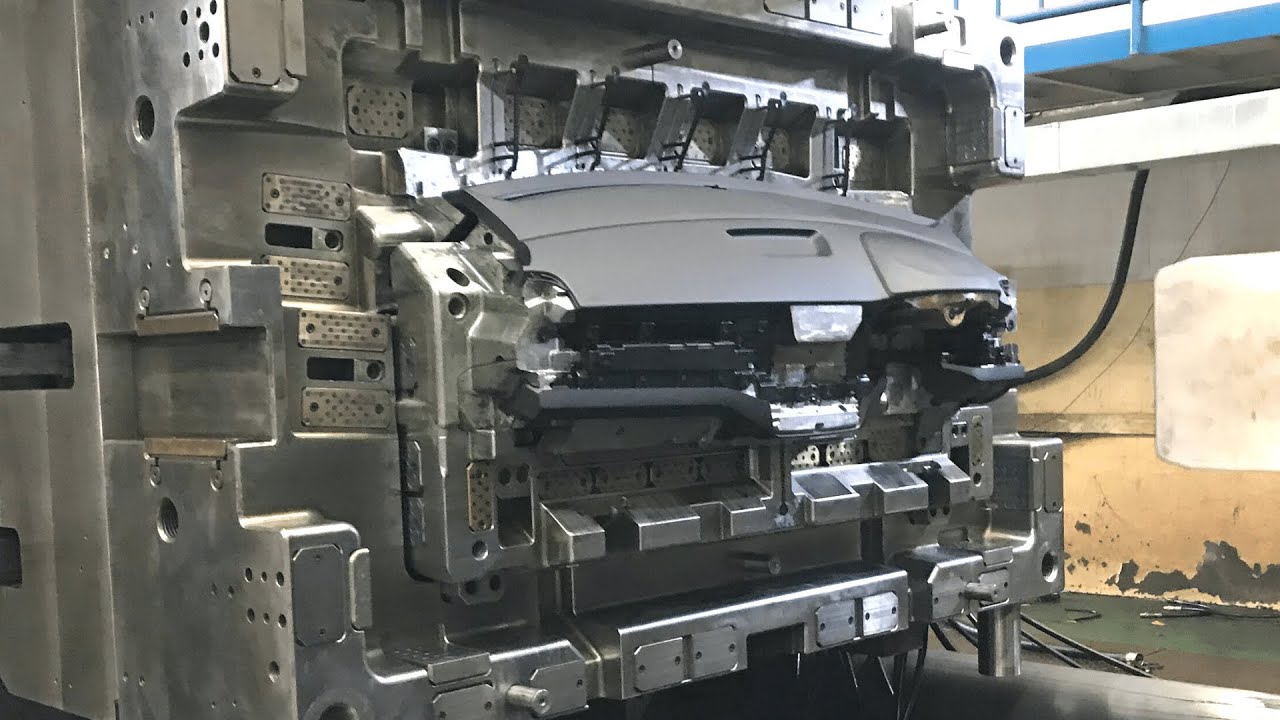What is Large Part Injection Molding?
Large part injection molding is a type of injection molding process used to produce sizable plastic components. Like all injection molding techniques, it works by injecting molten plastic material into a mold cavity under intense heat and pressure. As the plastic solidifies, it hardens into the shape of the mold.
Large part injection molding differs from conventional injection molding in the size of parts it can produce. Using larger machines and molds, this technique can create massive components measuring several feet across with relative ease.

Why Large Part Injection Molding is Necessary
Standard injection molding machines generate a clamping force between 50 to 500 tons. This allows them to produce small to moderately sized parts using molds with small surface areas.
However, when molding expansive components like industrial tanks, truck bedliners, or kayak hulls, substantially greater clamping pressure is required. Producing sizable parts demands larger surface area molds and intensified clamping force to keep the mold closed against the elevated injection pressure.
Machines designed explicitly for large part injection molding supply 500+ tons of clamp clamping force. Some mega-ton machines can exert over 4,000 tons of pressure! Only with brute strength like this is it possible to mold colossal components.
What Qualifies As A “Large Part”?
In the plastics manufacturing realm, “large part” is an informal designation rather than an exact specification. That said, industry insiders tend to categorize parts weighing over 20 pounds as large.
Likewise, any component with at least one dimension measuring over 30 inches tends to necessitate large part injection molding equipment. Still, smaller parts can also be considered “large” if they require 500+ ton machines for successful production.
Large Part Injection Molding Machines
Successfully molding big components demands some seriously beefy machinery. Large part injection molding machines have these defining traits:
- Giant Platens – The moving “plates” that supply clamping force are immense, often 8 x 8 feet or larger.
- Powerful Clamping Units – Hydraulic cylinders generating 500 to over 4,000 tons of locking force.
- High Shot Capacity – Barrels holding hundreds of pounds of molten resin.
- Big Molds – Enormous tooling weighing upwards of 50,000 pounds.
- Robust Construction – Built heavier duty to withstand tremendous recurring loads.
This plus-sized equipment allows the production of huge components like poly kayak hulls, industrial chemical tanks with 120-inch diameters, truck bedliners, and agricultural feed bins larger than hot tubs!
Special Requirements
Running mega-ton plastic molding machinery demands extensive infrastructure and auxiliary equipment:
- Facilities – Plants must accommodate 40 x 15 x 15 foot machines weighing up to 160 tons!
- Power – Special electrical systems supply the massive power these giants require.
- Plastics Handling – Conveying equipment moves resins from railcars and bulk trucks.
- Mold Handling – Bridge cranes lift and position molds weighing 50,000+ lbs.
- Part Handling – Forklifts and pallet jacks move bulky components.
- Secondary Operations – Paint lines, pad printing stations decorate big parts.
Large Part Injection Molding Process
While extremes of size and force are used, the underlying process remains similar to conventional injection molding. Here is the sequence:
1. Clamping
To start, the two halves of the mold are closed and pressed together with great force by the machine’s platens. Guide rods ensure proper alignment as the mold closes.
2. Injection
Next, the injection unit melts plastic resin and injects it into the mold through the sprue. The liquid plastic flows through runners that direct it into every crevice of the cavity.
3. Cooling
Channels cut into the tooling circulate temperature-regulated water, cooling the plastic. As it solidifies, the parts shrink slightly away from the mold walls.
4. Ejection
Lastly, the platen opens, the parts are ejected using pins, and the mold closes to repeat the cycle.
Machines routinely mold components approaching the maximum size limits of the clamping unit. Cycle times range from 45 seconds to five minutes depending on part size and other factors.
Applications of Large Part Injection Molding
Heavy industry relies on sizable molded components for numerous applications:
- Material Handling – Totes, bins, crates, gaylords, tanks, cases.
- Transportation – Truck bed liners, tractor fenders, RV holding tanks.
- Agriculture – Seed bins, liquid tanks, auger housings.
- Construction – Concrete forms, trench shoring towers, barrier walls.
- Fluid Power – Valve bodies, reservoirs, fittings, manifolds.
- Recreation – Kayak hulls, snowmobile cowls, horse trailer flooring.
These applications share common requirements like weather resistance, toughness, stability, and shock absorption that make plastic suitable.
And anything requiring repeated production of enormous parts finds the throughput of injection molding advantageous. Heavy industry around the globe depends on super-sized plastic components!
Key Takeaways on Large Part Injection Molding
- It’s a variant of injection molding that uses oversized equipment to produce giant plastic components.
- Weight and dimensions determine what qualifies as a “large part”.
- these processes employ 500+ ton clamping force injection molding machines.
- Applications include industrial tanks, truck bedliners, kayak hulls, and more.
- Despite the extremes involved, the underlying approach resembles conventional injection molding.
So for fabrication of mammoth plastic parts in the hundreds of units, large part injection molding is the technique of choice!
